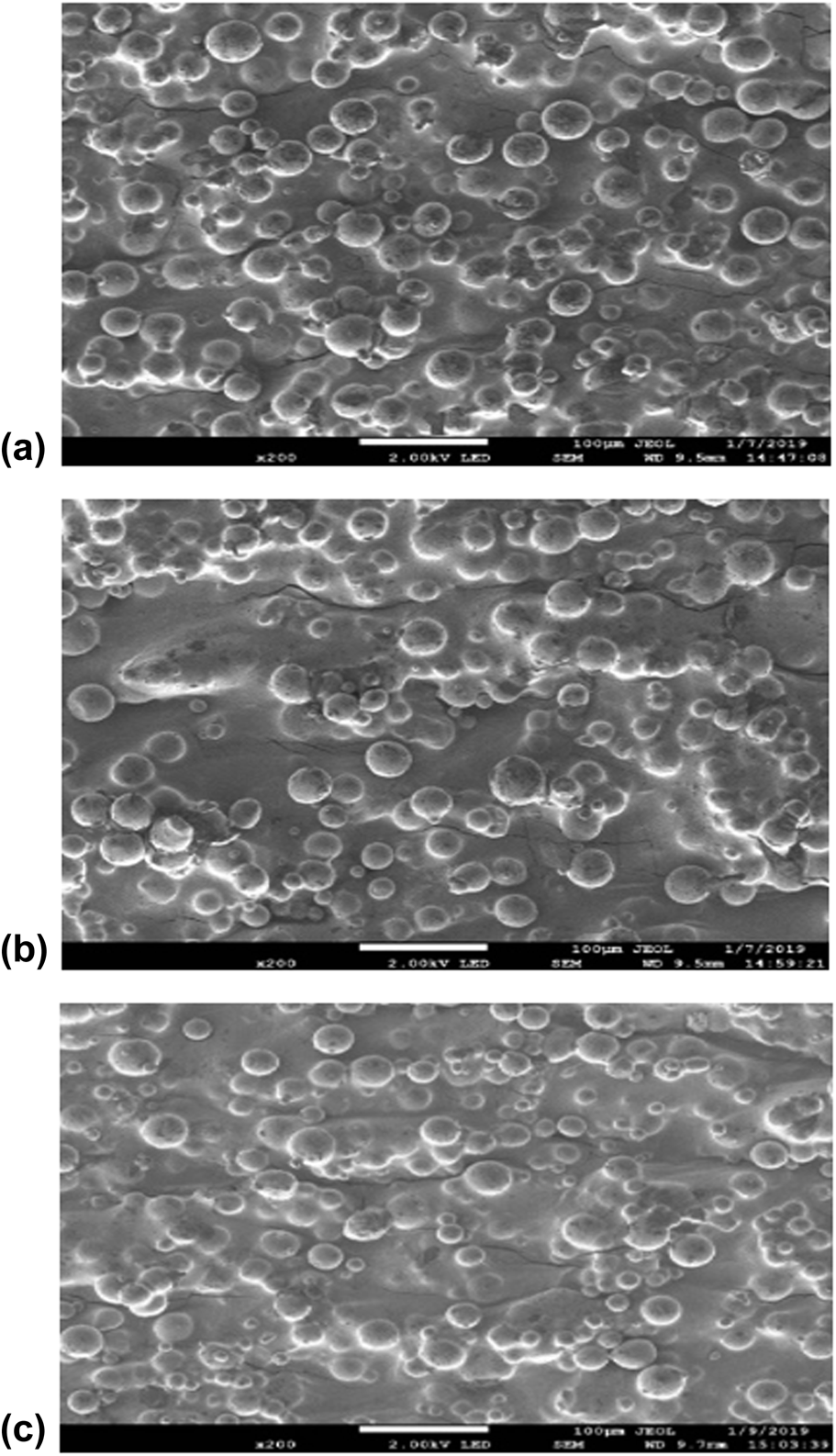Crossref Citations
This article has been cited by the following publications. This list is generated based on data provided by
Crossref.
Savinov, Roman
Wang, Yachao
Wang, Jin
and
Shi, Jing
2021.
Comparison of microstructure and properties of CoCrFeMnNi high-entropy alloy from selective laser melting and directed energy deposition processes.
Procedia Manufacturing,
Vol. 53,
Issue. ,
p.
435.
Ullah, Abid
Ur Rehman, Asif
Salamci, Metin Uymaz
Pıtır, Fatih
and
Liu, Tingting
2022.
The influence of laser power and scanning speed on the microstructure and surface morphology of Cu2O parts in SLM.
Rapid Prototyping Journal,
Vol. 28,
Issue. 9,
p.
1796.
Cunha, Ângela
Marques, Ana
Silva, Mariana Rodrigues
Bartolomeu, Flávio
Silva, Filipe Samuel
Gasik, Michael
Trindade, Bruno
and
Carvalho, Óscar
2022.
Laser powder bed fusion of the steels used in the plastic injection mould industry: a review of the influence of processing parameters on the final properties.
The International Journal of Advanced Manufacturing Technology,
Vol. 121,
Issue. 7-8,
p.
4255.
Sefene, Eyob Messele
2022.
State-of-the-art of selective laser melting process: A comprehensive review.
Journal of Manufacturing Systems,
Vol. 63,
Issue. ,
p.
250.
Mostahsan, Amirhossein Jabbari
and
Farahmand, Farzam
2022.
Influence of cleaning process on mechanical properties and surface characteristics of selective laser melted Ti6Al4V parts prepared for medical implant applications.
Journal of Materials Research,
Vol. 37,
Issue. 16,
p.
2546.
AYDIN, Dilara Selma
ÖZSOY, Arif Lütfi
and
YILDIRIM, Çağrı Vakkas
2022.
Ti6Al4V Alaşımının SLM Yöntemiyle Üretilmesinde Taguchi Metodu Kullanılarak Proses Parametrelerinin Optimizasyonu.
International Journal of Innovative Engineering Applications,
Vol. 6,
Issue. 2,
p.
230.
Cerri, Emanuela
Ghio, Emanuele
and
Bolelli, Giovanni
2022.
Effect of surface roughness and industrial heat treatments on the microstructure and mechanical properties of Ti6Al4V alloy manufactured by laser powder bed fusion in different built orientations.
Materials Science and Engineering: A,
Vol. 851,
Issue. ,
p.
143635.
Praveen Kumar, D.
and
Vinoth Jebaraj, A.
2022.
Role of Volumetric Energy Density and Post-Heat Treatments to Achieve Stable Microstructure on Additive Manufactured Ti6Al4V Alloy.
Transactions of the Indian Institute of Metals,
Vol. 75,
Issue. 12,
p.
3077.
Yang, Guodong
Zhang, Jialian
Xie, Houbo
Li, Faliang
Huang, Zhong
Yuan, Gaoqian
Zhang, Jingzhe
Jia, Quanli
Zhang, Haijun
Yeprem, Hasibe Aygul
and
Zhang, Shaowei
2022.
Preparation of B4Cp/Al Composites via Selective Laser Melting and Their Tribological Properties.
Materials,
Vol. 15,
Issue. 23,
p.
8340.
Primus, Tomáš
Beránek, Libor
Pitrmuc, Zdeněk
Šimota, Jan
and
Zeman, Pavel
2022.
Laser polishing of additively manufactured 316L stainless steel with different construction angles.
The International Journal of Advanced Manufacturing Technology,
Vol. 121,
Issue. 5-6,
p.
3215.
Gao, Chaofeng
Tang, Huaping
Zhang, Shiheng
Ma, Zhibo
Bi, Yunjie
and
Rao, Jeremy-Heng
2022.
Process Optimization for Up-Facing Surface Finish of AlSi10Mg Alloy Produced by Laser Powder Bed Fusion.
Metals,
Vol. 12,
Issue. 12,
p.
2053.
Aufa, A.N.
Hassan, Mohamad Zaki
and
Ismail, Zarini
2022.
Recent advances in Ti-6Al-4V additively manufactured by selective laser melting for biomedical implants: Prospect development.
Journal of Alloys and Compounds,
Vol. 896,
Issue. ,
p.
163072.
Wang, Shuhao
Ning, Jinsheng
Zhu, Lida
Yang, Zhichao
Yan, Wentao
Dun, Yichao
Xue, Pengsheng
Xu, Peihua
Bose, Susmita
and
Bandyopadhyay, Amit
2022.
Role of porosity defects in metal 3D printing: Formation mechanisms, impacts on properties and mitigation strategies.
Materials Today,
Vol. 59,
Issue. ,
p.
133.
Soundarapandiyan, Gowtham
Leung, Chu Lun Alex
Johnston, Carol
Bhatt, Alisha
H.U. Khan, RAJA
McNutt, Phil
Atwood, Robert C.
Lee, Peter
Chen, Bo
and
Fitzpatrick, Michael E.
2022.
Effects of Ti6al4v Powder Oxidation on Process Dynamics in Laser Powder Bed Fusion Additive Manufacturing.
SSRN Electronic Journal ,
Duan, Weipeng
Wu, Meiping
Han, Jitai
Ma, Yiqing
and
Miao, Xiaojin
2022.
Effect of layer thickness on the overhanging surface quality manufactured by selective laser melting.
Proceedings of the Institution of Mechanical Engineers, Part C: Journal of Mechanical Engineering Science,
Vol. 236,
Issue. 9,
p.
4818.
Elambasseril, Joe
Rogers, Jason
Wallbrink, Chris
Munk, David
Leary, Martin
and
Qian, M.
2023.
Laser powder bed fusion additive manufacturing (LPBF-AM): the influence of design features and LPBF variables on surface topography and effect on fatigue properties.
Critical Reviews in Solid State and Materials Sciences,
Vol. 48,
Issue. 1,
p.
132.
Soundarapandiyan, Gowtham
Leung, Chu Lun Alex
Johnston, Carol
Chen, Bo
Khan, Raja H.U.
McNutt, Phil
Bhatt, Alisha
Atwood, Robert C.
Lee, Peter D.
and
Fitzpatrick, Michael E.
2023.
In situ monitoring the effects of Ti6Al4V powder oxidation during laser powder bed fusion additive manufacturing.
International Journal of Machine Tools and Manufacture,
Vol. 190,
Issue. ,
p.
104049.
Rehman, Mudassar
Wang, Yanen
Ishfaq, Kashif
Mushtaq, Ray Tahir
Kumar, M. Saravana
and
Yang, Haiou
2023.
Potential assessment in laser powder bed fusion of bionic porous Ti scaffolds concerning compressive behavior, porosity, and surface roughness.
Journal of Manufacturing Processes,
Vol. 95,
Issue. ,
p.
461.
Lu, Xuben
Shu, Chang
Zheng, Zhiyu
Shu, Xuedao
Chen, Siyuan
Essa, Khamis
Li, Zixuan
and
Xu, Haijie
2023.
Effects of L-PBF Scanning Strategy and Sloping Angle on the Process Properties of TC11 Titanium Alloy.
Metals,
Vol. 13,
Issue. 5,
p.
983.
Praveen Kumar, Devaraj
and
Vinoth Jebaraj, Alfred
2023.
Surface morphology and dimensional accuracy of additively manufactured Ti-6Al-4V alloy: Effect of variable scanning speed with constant laser power in widespread energy density.
Proceedings of the Institution of Mechanical Engineers, Part L: Journal of Materials: Design and Applications,
Vol. 237,
Issue. 9,
p.
1964.
